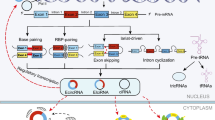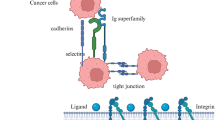Abstract
The application of small interfering RNA (siRNA) oligonucleotides to silence gene expression has profound implications for the intervention of human diseases including cancer. Using this technique, we explored the possibility that the α6β4 integrin, a laminin adhesion receptor with a recognized role in the invasive phenotype of many carcinomas, represents a potential therapeutic target to inhibit the migration and invasion of carcinoma cells. We found that siRNA oligonucleotides targeted to either subunit of the α6β4 integrin reduced cell surface expression of this integrin and resulted in decreased invasion of MDA-MB-231 breast carcinoma cells. Interestingly, reduced α6β4 expression also promoted decreased migration on non-laminin substrata indicating that this integrin can function in a ligand-independent manner. In addition, the absence of β4 expression in these cells augmented the formation of α6β1 heterodimers and increased adhesion to laminin-1. Taken together, these results substantiate the importance of the α6β4 integrin in invasion and migration that has been demonstrated previously by expression of the β4 subunit in β4-deficient cell lines and by function blocking antibodies. Furthermore, these data suggest that the utilization of siRNA oligonucleotides to reduce the expression of the α6β4 integrin may be a useful approach to prevent carcinoma cell progression.
Similar content being viewed by others
References
Hammond SM, Caudy AA, Hannon GJ. Post-transcriptional gene silencing by double-stranded RNA. Nat Rev Genet 2001; 2: 110–9.
Hutvagner G, Zamore PD. RNAi: Nature abhors a double-strand. Curr Opin Genet Dev 2002; 12: 225–32.
Sharp PA. RNA interference-20 01. Genes Dev 2001; 15: 485–90.
Caplen NJ, Parrish S, Imani F et al. Specific inhibition of gene expression by small double-stranded RNAs in invertebrate and vertebrate systems. Proc Natl Acad Sci USA 2001; 98: 9742–7.
Elbashir SM, Harborth J, Lendeckel W et al. Duplexes of 21-nucleotide RNAs mediate RNA interference in cultured mammalian cells. Nature 2001; 411: 494-8.
Tuschl T, Zamore PD, Lehmann R et al. Targeted mRNA degradation by double-stranded RNA in vitro. Genes Dev 1999; 13: 3191–7.
Mercurio AM, Rabinovitz I. Towards a mechanistic understanding of tumor invasion-lessons from the alpha6beta 4 integrin. Semin Cancer Biol 2001; 11: 129–41.
Mercurio AM, Rabinovitz I, Shaw LM. The alpha 6 beta 4 integrin and epithelial cell migration. Curr Opin Cell Biol 2001; 13: 541–5.
Mercurio A. Receptors for the laminins. Achieving specificity through cooperation. Trends Cell Biol 1995; 5: 419–23.
O'Connor KL, Shaw LM, Mercurio AM. Release of cAMP gating by the alpha6beta4 integrin stimulates lamellae formation and the chemotactic migration of invasive carcinoma cells. J Cell Biol 1998; 143: 1749–60.
Trusolino L, Bertotti A, Comoglio PM. A signaling adapter function for alpha6beta4 integrin in the control of HGF-dependent invasive growth. Cell 2001; 107: 643–54.
Hemler ME, Crouse C, Sonnenberg A. Association of the VLA alpha 6 subunit with a novel protein. A possible alternative to the common VLA beta 1 subunit on certain cell lines. J Biol Chem 1989; 264: 6529–35.
Borradori L, Sonnenberg A. Structure and function of hemidesmosomes: More than simple adhesion complexes. J Invest Dermatol 1999; 112: 411–8.
Falcioni R, Sacchi A, Resau J, Kennel SJ. Monoclonal antibody to human carcinoma-associated protein complex: Quantitation in normal and tumor tissue. Cancer Res 1988; 48: 816–21.
Rabinovitz I, Toker A, Mercurio AM. Protein kinase C-dependent mobilization of the alpha6beta4 integrin from hemidesmosomes and its association with actin-rich cell protrusions drive the chemotactic migration of carcinoma cells. J Cell Biol 1999; 146: 1147–60.
Bachelder RE, Ribick MJ, Marchetti A et al. p53 inhibits alpha 6 beta 4 integrin survival signaling by promoting the caspase 3-dependent cleavage of AKT/PKB. J Cell Biol 1999; 147: 1063–72.
Chung J, Bachelder RE, Lipscomb EA et al. Integrin (alpha 6 beta 4) regulation of eIF-4E activity and VEGF translation: A survival mechanism for carcinoma cells. J Cell Biol 2002; 158: 165–74.
Chao C, Lotz MM, Clarke AC, Mercurio AM. A function for the integrin alpha6beta4 in the invasive properties of colorectal carcinoma cells. Cancer Res 1996; 56: 4811–9.
Shaw LM, Rabinovitz I, Wang HH et al. Activation of phosphoinositide 3-OH kinase by the alpha6beta4 integrin promotes carcinoma invasion. Cell 1997; 91: 949–60.
Falcioni R, Antonini A, Nistico P et al. Alpha 6 beta 4 and alpha 6 beta 1 integrins associate with ErbB-2 in human carcinoma cell lines. Exp Cell Res 1997; 236: 76–85.
Gambaletta D, Marchetti A, Benedetti L et al. Cooperative signaling between alpha(6)beta(4) integrin and ErbB-2 receptor is required to promote phosphatidylinositol 3-kinase-dependent invasion. J Biol Chem 2000; 275: 10604–10.
Shaw LM. Identification of insulin receptor substrate 1 (IRS-1) and IRS-2 as signaling intermediates in the alpha6beta4 integrindependent activation of phosphoinositide 3-OH kinase and promotion of invasion. Mol Cell Biol 2001; 21: 5082–93.
Dans M, Gagnoux-Palacios L, Blaikie P et al. Tyrosine phosphorylation of the beta 4 integrin cytoplasmic domain mediates Shc signaling to extracellular signal-regulated kinase and antagonizes formation of hemidesmosomes. J Biol Chem 2001; 276: 1494–502.
Mainiero F, Pepe A, Yeon M et al. The intracellular functions of alpha6beta4 integrin are regulated by EGF. J Cell Biol 1996; 134: 241–53.
O'Connor KL, Nguyen BK, Mercurio AM. RhoA function in lamellae formation and migration is regulated by the alpha6beta4 integrin and cAMP metabolism. J Cell Biol 2000; 148: 253–8.
Jauliac S, Lopez-Rodriguez C, Shaw LM et al. The role of NFAT transcription factors in integrin-mediated carcinoma invasion. Nat Cell Biol 2002; 4: 540-4.
Brummelkamp TR, Bernards R, Agami R. A system for stable expression of short interfering RNAs in mammalian cells. Science 2002; 296: 550–3.
Paddison PJ, Caudy AA, Bernstein E et al. Short hairpin RNAs (shRNAs) induce sequence-specific silencing in mammalian cells. Genes Dev 2002; 16: 948–58.
Sui G, Soohoo C, Affar EB et al. A DNA vector-based RNAi technology to suppress gene expression in mammalian cells. Proc Natl Acad Sci USA 2002; 99: 5515–20.
Rezniczek GA, de Pereda JM, Reipert S, Wiche G. Linking integrin alpha6beta4-based cell adhesion to the intermediate filament cytoskeleton: direct interaction between the beta4 subunit and plectin at multiple molecular sites. J Cell Biol 1998; 141: 209–25.
Hintermann E, Bilban M, Sharabi A, Quaranta V. Inhibitory role of alpha 6 beta 4-associated erbB-2 and phosphoinositide 3-kinase in keratinocyte haptotactic migration dependent on alpha 3 beta 1 integrin. J Cell Biol 2001; 153: 465–78.
Nguyen BP, Gil SG, Carter WG. Deposition of laminin 5 by keratinocytes regulates integrin adhesion and signaling. J Biol Chem 2000; 275: 31896–907.
McCaffrey AP, Meuse L, Pham TT et al. RNA interference in adult mice. Nature 2002; 418: 38-9.
Lewis DL, Hagstrom JE, Loomis AG et al. Efficient delivery of siRNA for inhibition of gene expression in postnatal mice. Nat Genet 2002; 32: 107–8.
Brummelkamp T, Bernards R, Agami R. Stable suppression of tumorigenicity by virus-mediated RNA interference. Cancer Cell 2002; 2: 243.
Author information
Authors and Affiliations
Corresponding author
Rights and permissions
About this article
Cite this article
Lipscomb, E.A., Dugan, A.S., Rabinovitz, I. et al. Use of RNA interference to inhibit integrin (α6β4)-mediated invasion and migration of breast carcinoma cells. Clin Exp Metastasis 20, 569–576 (2003). https://doi.org/10.1023/A:1025819521707
Issue Date:
DOI: https://doi.org/10.1023/A:1025819521707




